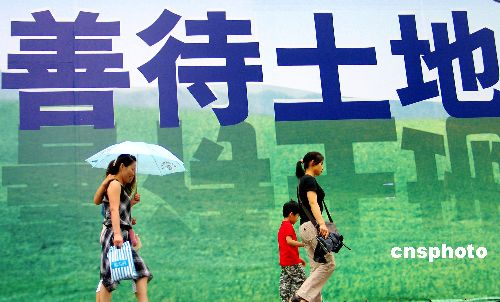Eight years after his arable land was polluted by heavy metals, Zhou Xiaobing finally saw hope of a harvest out of the infertility.
 |
|
File photo: A picture poster reads a slogan of "Protect the Land".
|
"I don't know what magic they used, but, you see, the land is covered with plants again," said the 37-year-old farmer in south China's Huanjiang County, Guangxi Zhuang Autonomous Region.
In 2001, flood water from the Huanjiang River carried mineral processing industry wastes from tailings dams of three major mining companies on the upper reaches to lower watercourses, causing infertility in more than 5,000 mu (about 333.3 hectares) of arable land including Zhou's 0.6 mu.
"This place didn't even grow a blade of grass at that time," Zhou said, standing beside his land, which, he claimed, used to yield 500 kilograms of grains a year.
Now it is part of a 30-mu soil recovery base set up by one of China's leading soil cleaning experts Chen Tongbin and his team in 2005.
Chen uses plants, such as a home-grown fern, to "suck up" heavy metals like arsenic, copper and zinc, from contaminated soil.
The team, nearly 40 members in total, engaged in soil recovery projects in Hunan, Guangxi, Yunnan, Guangdong and Beijing, with an aggregated area of more than 200 mu. The base set up in Chenzhou, central China's Hunan Province, in 2001 was the first arsenic-polluted soil recovery base in the world.
"Unlike the first base that only used the fern to rehabilitate the land, we tried intercropping in this base," said Chen, principal investigator at the Center for Environmental Remediation of the Chinese Academy of Sciences (CAS) Institute of Geographical Sciences and Natural Resources Research.
They arranged the fern and cash crops including maize, sugar cane, and mulberry in alternate rows.
"We can rehabilitate the land and have yields at the same time," he said. "It could help to increase farmer's income."
Last year, the maize in the base grew so good that villagers flocked to harvest them, Chen said. His team members had to be on guard to tell the villagers the maize was not safe yet for eating as poisonous elements had not been cleaned up.
"Farmers are quite pragmatic," he said. "If it has no economic benefit at all, the technology can hardly be promoted for wider use."
The center estimated that with an annual input of 2,000 to 3,000 yuan (about US$437.7) per mu, the farmer could expect a net income of 1,000 to 1,500 yuan in return.
Through three years of rehabilitation in the base, the soil's PH value got back to normal, the amount of arsenic in the soil was cut by 12 percent, the yield and quality of mulberry leaves had not been affected, and heavy metal contained in silk and silkworm pupa did not exceed the national level, according to the Center for Environmental Remediation.
Compared to water and air, soil contamination is the most dangerous because it is hidden and can only be reversed by human intervention as nature cannot do it, Chen said.
"It'll take at least three to five years for even the moderately-polluted land to recover," he said.
Arsenic and many of its compounds are especially potent poisons and commonly used as pesticides, herbicides, and insecticides.
"Long-time exposure to arsenic might induce cancer, and high-dose arsenic could lead to death," he said.
"In arsenic-polluted areas, the amount of arsenic in people's hair was several times higher than the normal level," he said.
Arsenic aroused the memory of a spate of tragedies in China last year.
A high concentration of arsenic was recorded in water from Yangzonghai Lake in southwest China's Yunnan Province last June caused by leakage in a sub-standard waste water pool at a nearby factory.
In September last year, 26 local officials were given administrative punishment (ranging from a warning through to demotion and the sack) in relation to the case, including the removal of 12 from their posts.
In a separate case in October, 2008, 450 people were sickened after drinking contaminated water in Hechi city in Guangxi, including four with arsenic poisoning.
Hechi City authority said a typhoon triggered torrential rain in September in the area. Waste water containing arsenic overflowed from a company's premises and polluted nearby ponds and wells.